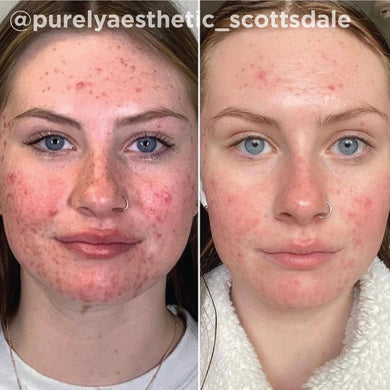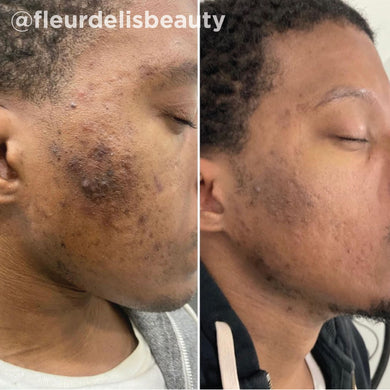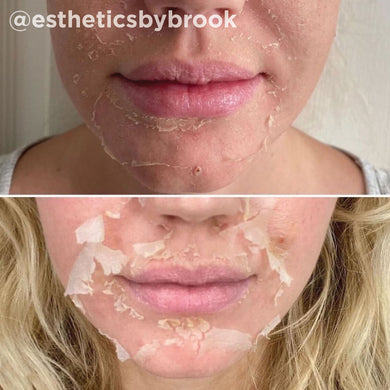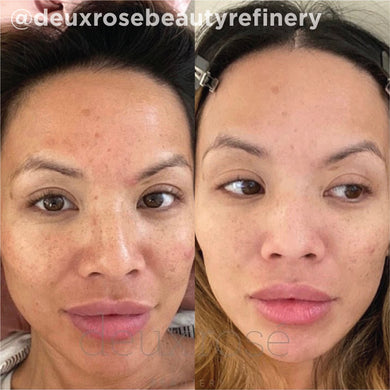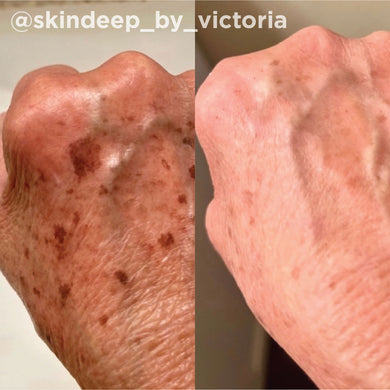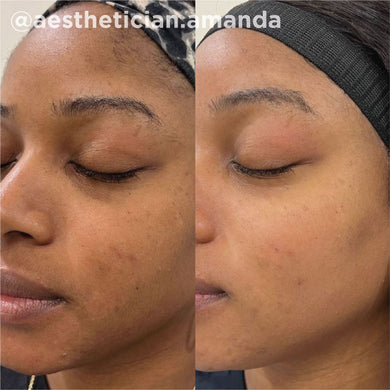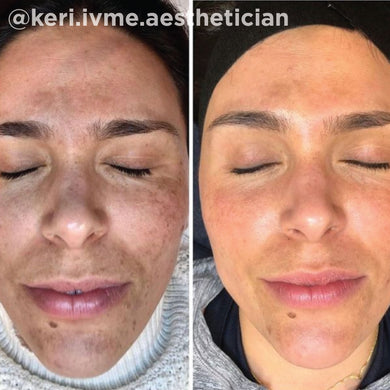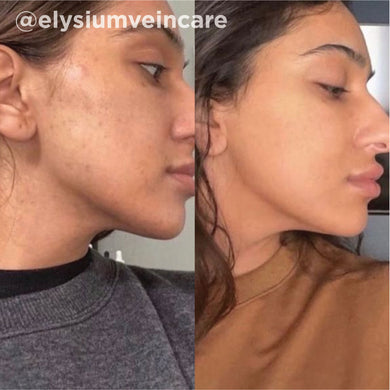Dermatologist Q&A
Written by Corey L. Hartman M.D., FAAD as part of The Brown Skin Agenda Initiative.
Think nothing is worse than a wrinkle? Dermatologists like me would beg to differ. Often, my patients find hyperpigmentation (also called dark spots or sunspots) to also be a big barrier to their healthiest-looking skin—regardless of how light or how deep their skin tone. And, while wrinkles have a quick cosmetic fix in the form of injections or temporary line fillers, hyperpigmentation and dark spots are more stubborn and require diligence and patience. When treating hyperpigmentation, I tell my patients to think “more marathon, less sprint.”
When treating my darker skinned patients for hyperpigmentation, the lack of or the intensity of melanin (pigment) in your skin must always be taken into consideration. And you might be surprised to hear that hyperpigmentation treatment options for darker skin (Fitzpatrick skin types 3, 4, 5, and 6) differ from hyperpigmentation treatment for lighter skin (Fitzpatrick skin type 1 and 2), and this can be the difference between relieving hyperpigmentation patients of color or intensifying it.
But first, what is hyperpigmentation and what are its causes?
Regardless of color, all skin contains melanocyte cells that produce melanin and gives our skin and hair its color. When excess melanin is produced, hyperpigmentation spots or patches that are darker than the surrounding skin appear.
Regardless of skin tone, hyperpigmentation can be triggered by:
- An inflammatory process like acne or eczema
- Cumulative exposure to UV or an intense burn
- Starting a new medication/prescription
- Hormonal shifts
Why do black and brown skin experience hyperpigmentation differently?
Darker skin has larger melanosomes that contain more melanin (pigment), therefore, inflammation in darker skin can cause more severe discoloration after inflammation or injury than lighter skin. This is also called post-inflammatory hyperpigmentation, or PIH, which is a condition that disproportionately affects more darker skinned patients than lighter skinned counterparts. This also makes dark spots and hyperpigmentation on darker skin more stubborn, longer lasting, and more difficult to treat—but not impossible. There are specific procedures and ingredients that are ideal for fading dark spots on darker skin, whether from hormonal imbalance, sun exposure or post-inflammatory hyperpigmentation, and some that are not.
Best hyperpigmentation treatment options for skin of color
Hyperpigmentation treatment for dark skin, especially treatment for post-inflammatory hyperpigmentation, must walk a fine line between treating the condition and worsening it. These are a few of the tried-and-true treatment protocols I prescribe for my darker skinned patients:
- Medium-depth chemical peels
Professionally administered chemical peels come in three intensities: superficial (light), medium-depth, and deep. The more intense the peel, the more dramatic the results—but recovery time increases with intensity, and, if the hyperpigmentation treatment is too intense, it can trigger post-inflammatory hyperpigmentation.
Medium-depth chemical peels are a safe and effective treatment option for hyperpigmentation in patients of color. I typically prescribe peels with less than 15% TCA (trichloroacetic acid), like the VI Peel. It’s important to note the percentage of TCA in the peels you use, because a concentration too high can potentially cause an inflammatory response, leading to post-inflammatory hyperpigmentation. VI Peels are great because it’s painless and the level of TCA is below 15% potency: high enough to fade dark spots without triggering an inflammatory response. Remember that chemical peels shouldn’t be synonymous with pain: You can treat hyperpigmentation successfully with a medium-depth peel that doesn’t cause intense discomfort.
- Non-ablative lasersWhen treating hyperpigmentation, dark spots, and dark patches, many board-certified dermatologists like myself recommend non-ablative lasers like Aerolase (used for overall skin rejuvenation), Fraxel (used to target and fade dark spots), as well as Clear + Brilliant and Picosure to manage hyperpigmentation on all skin tones. It’s also very important to note that not all laser treatments are safe for skin of color, especially ablative lasers which can cause post-inflammatory hyperpigmentation. Always make sure to speak with a medical professional with experience in treating skin of color to create a treatment path that’s right for your skin tone.
- Microneedling The microneedle is a device with tiny needles that punctures the surface of the skin with just enough pressure to trigger the skin’s healing response. This healing response then stimulates collagen production that ultimately helps with common skin aging concerns like texture, and elasticity. While microneedling is typically more focused on treatment of textural issues like acne scarring, rough texture, and elasticity, it can also help to break up excess pigment in your skin. It’s best to combine microneedling with something that can help lift unwanted pigment, like the VI Peel.
This emerging therapeutic option to manage hyperpigmentation on dark skin has gotten a bad rap for fear that it will stimulate post-inflammatory hyperpigmentation (PIH). However, it is a safe dark spot treatment for all skin tones. While microneedling does cause skin injury, it won’t trigger PIH in skin because the injury is so small (hence the name micro) and confined to the skin’s surface.
Best topical ingredients to fight hyperpigmentation in darker skin
Cysteamine and hydroquinone are two prescription-only ingredients I often use in my practice to manage hyperpigmentation and to even out the skin tone, but there is a plethora of non-prescription options that are also great adjunct treatments. These ingredients include TXA (tranexamic acid), azelaic acid, kojic acid, niacinamide, and other alpha hydroxy acids like lactic acid and mandelic acid. These are all helpful, especially when used in combination, for relieving uneven skin tone. It’s also important to remember that prolonged sun exposure makes hyperpigmentation worse and can disrupt and even worsen your treatment cycle. Always use an SPF of 30 or higher, even on cloudy days. I recommend the VI Derm SPF 50 sunscreen, which is great lightweight option for skin of color.
One product that does a phenomenal job at lightening hyperpigmentation and dark spots in all skin tones is Vitality Institute’s new VI Derm Dark Spot Lifting Serum with 5% Tranexamic Acid (TXA). This product delivers dark-spot fading results that are comparable to a prescription-grade product, and it includes four of the proven skin brighteners I mentioned above: tranexamic acid, kojic acid, lactic acid, and niacinamide. Together, these ingredients create a powerful combination therapy that corrects existing discoloration and prevents future pigmentation safely, without triggering PIH in skin. For maximum effectiveness, use it two times daily for at least a few months, in conjunction with a daily SPF.
Topical ingredients and professional treatments to avoid if you have dark skin
Black and brown skin do not traditionally respond well to ablative resurfacing lasers or deep chemical peels. These two treatments can cause controlled injuries that go too deep into the skin and cause too much melanocyte disruption. This severity can cause increased heat and epidermal damage that can worsen hyperpigmentation and PIH.
TCA treatments above 15% are generally regarded as too harsh for darker skin tones and can lead to unpredictable results that cause hyperpigmentation and hypopigmentation.
Lastly, it’s also important to remember that everyone’s skin responds differently to different types of treatments based on their DNA, past skin history, environment, and so much more. Make sure to speak with your healthcare professional to set up a treatment path that’s right for your skin that’s completely unique to you.
About Corey Hartman, MD, FAAD
Corey L. Hartman, MD, is the founder and medical director of Skin Wellness Dermatology in Birmingham, Alabama. In addition, he is Assistant Clinical Professor of Dermatology at the University of Alabama School of Medicine. A native of New Orleans, Dr. Hartman attended Emory University, graduating with a Bachelor of Arts in Psychology. After earning a doctorate of medicine from Meharry Medical College in Nashville, Tennessee, he completed an internship in Internal Medicine at Tulane University Medical Center and a residency in Dermatology at the University of Alabama School of Medicine. Dr. Hartman is certified by the American Board of Dermatology and is a fellow of the American Academy of Dermatology and the American Society for Dermatologic Surgery.
Dr. Hartman has a special interest in Dermatologic Surgery, Injectables, Hair Restoration, and Laser Dermatology. He frequently speaks on cosmetic procedures and social media marketing in dermatology at meetings around the country. Dr. Hartman was voted 2016 Best of Birmingham: Dermatologist by the readers of Birmingham Magazine and the 2018 Best Dermatologist by the readers of About Town Magazine. Most recently, Dr. Hartman was named to the Board of Directors of the Skin of Color Society.
